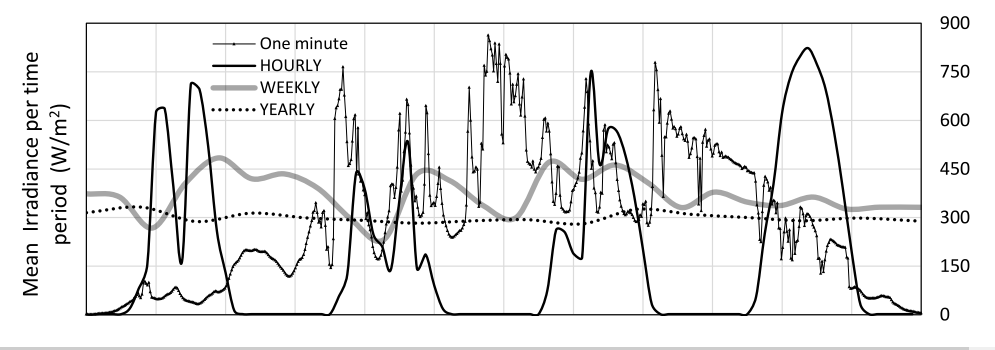Introduction
The direct normal component of the solar resource is variable in time and space. The value of the DNI incident on a site varies throughout the day and depends on the climate of the location. Its value has a deterministic and a stochastic component. The deterministic component is caused by the apparent daily motion of the sun in the sky and the Earth-Sun distance. This component can be calculated by means of the Earth-Sun geometrical equations. The stochastic and less predictable component is caused by several agents but the main one is the motion of the clouds. Clouds have a stochastic behavior difficult to forecast at high temporal resolutions. In the absence of clouds, the atmospheric components such as aerosols also have an influence, although these parameters are slowly varying and do not significantly influence solar radiation at high temporal resolutions. Both agents are dependent on the climatic features of the area and, for high resolutions, on the microclimatic features of the location. So, the variability of the DNI could be quantified through estimating dispersion during a specific period (temporal variability) or over a specific area (spatial variability).
The variability can be expressed as the coefficient of variation (COV) for variables having a normal distribution, as the variance for any other known statistical distribution, or as the interquartile range when the distribution is unknown. COV is obtained by dividing the standard deviation by the mean of the population or sample (Sengupta et al., 2017).
(B) Feasibility
In the feasibility stage, an annual dataset of DNI values, or Typical Solar Years (TSYs) (Lara-Fanego et al., 2016), is developed through a long-term dataset of measurements or modelled data. This dataset should statistically represent the solar resource behavior at the selected site, and therefore the temporal variability of the site. The inter-annual variability of the location can help to evaluate how long the reference dataset should be recommended, although a dataset as long as possible is desirable, in general, a minimum of 10 years is commonly accepted. So, the inter-annual variability is used to evaluate the uncertainty of the RSY dataset and, as a consequence, the representative annual production of the plant. On the other hand, when a long-term dataset is not available on-site, temporal variability at higher resolutions (monthly and daily) is also required to produce DNI long-term series (multiyears).
The recommended features for the solar radiation variability for this application are the following:
- Solar radiation variables for the variability assessment: DNI.
- Time resolution: annual.
- Spatial resolution: on site data.
- Period of records: >10 years.
| Users | ||||||||
| Proyect developers needs at diferent plant stages | Other users | |||||||
| Category of product service | (A) Pre-feasibility | (B) Feasibility & Design | (C) Due Diligence Financing | (D) Plant Accep-tance Test | (E) Systems or Plant Operations | (F) Grid operators | (G) Policy makers | (H) Education / Outreach |
| SOLAR RADIATION VARIABILITY | ✅ | ✅ | ✅ | ❌ | ❌ | ✅ | ✅ | ✅ |
|---|---|---|---|---|---|---|---|---|
DNI variability maps
In the context of a Solar Energy project, the spatial variability of the DNI is mainly used in the pre-feasibility stage to assess the suitability of datasets from nearby locations when a quality dataset on-site is not available.
Time series variability
The time variability is used in different stages of the project and for different time resolutions, from annual to daily resolution. As the stages of the project progress, the resolution of the variability evaluated increases. Figure 9 shows how the variability of a GHI time series at a North American location varies depending on the integration time (Perez et al., 2016).

The relevant features for the solar radiation variability are:
- Solar radiation variables for the variability assessment.
- Time resolution (from annual to hourly).
- Spatial resolution.
- Period of records.

